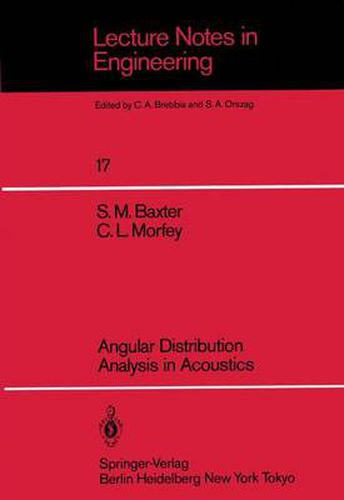Readings Newsletter
Become a Readings Member to make your shopping experience even easier.
Sign in or sign up for free!
You’re not far away from qualifying for FREE standard shipping within Australia
You’ve qualified for FREE standard shipping within Australia
The cart is loading…






This title is printed to order. This book may have been self-published. If so, we cannot guarantee the quality of the content. In the main most books will have gone through the editing process however some may not. We therefore suggest that you be aware of this before ordering this book. If in doubt check either the author or publisher’s details as we are unable to accept any returns unless they are faulty. Please contact us if you have any questions.
The purpose of this book is to j.irEURO’~ 0l'l\‘ a new technique for the experimental investigation of the free wave model sound field of acoustics. The technique is based on the use of spherical harmonic functions of angle. Acousticians frequently encounter random sound fields whose properties may be closely modelled by use of the free wave field. This model field is defined by two basic statistical properties: stationarity in time, and homogeneity in space. Stationarity means that any single order statistic measured by a microphone in the field will be independent of the time at which the recording is taken, while homogeneity means that the measurement will also be independent of the mic- phone’s position in the field. Furthermore, second order statistics obtained from the measurements of two microphones will depend only on the time lapse between the two recordings, and the relative spatial separation of the micro phones, and not on the microphones’ absolute positions in space and time. The free wave field may also (equivalently) be pictured as a collection of plane sound waves which approach an observation position from all angles. These are the free waves of the title, with no correlation between waves at different angles and frequencies, although there may exist an angle-dependant plane wave density function. This is a measure of the density of sound energy arriving from different angles. The free wave field has proved to be a simple but remarkably powerful model.
$9.00 standard shipping within Australia
FREE standard shipping within Australia for orders over $100.00
Express & International shipping calculated at checkout
This title is printed to order. This book may have been self-published. If so, we cannot guarantee the quality of the content. In the main most books will have gone through the editing process however some may not. We therefore suggest that you be aware of this before ordering this book. If in doubt check either the author or publisher’s details as we are unable to accept any returns unless they are faulty. Please contact us if you have any questions.
The purpose of this book is to j.irEURO’~ 0l'l\‘ a new technique for the experimental investigation of the free wave model sound field of acoustics. The technique is based on the use of spherical harmonic functions of angle. Acousticians frequently encounter random sound fields whose properties may be closely modelled by use of the free wave field. This model field is defined by two basic statistical properties: stationarity in time, and homogeneity in space. Stationarity means that any single order statistic measured by a microphone in the field will be independent of the time at which the recording is taken, while homogeneity means that the measurement will also be independent of the mic- phone’s position in the field. Furthermore, second order statistics obtained from the measurements of two microphones will depend only on the time lapse between the two recordings, and the relative spatial separation of the micro phones, and not on the microphones’ absolute positions in space and time. The free wave field may also (equivalently) be pictured as a collection of plane sound waves which approach an observation position from all angles. These are the free waves of the title, with no correlation between waves at different angles and frequencies, although there may exist an angle-dependant plane wave density function. This is a measure of the density of sound energy arriving from different angles. The free wave field has proved to be a simple but remarkably powerful model.